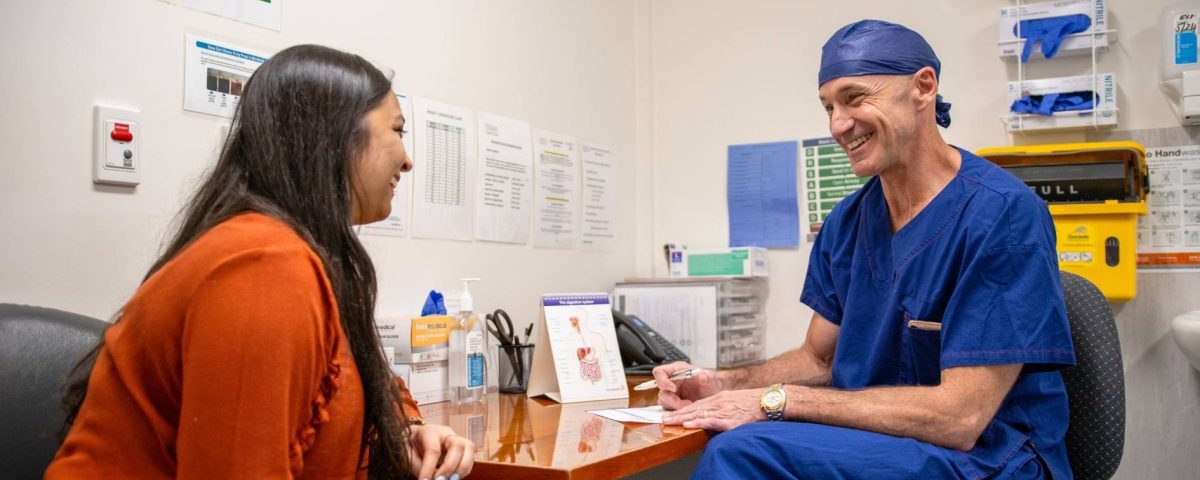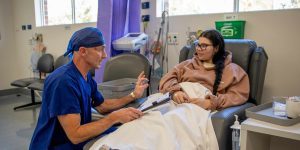
It might be hard to believe, but 60% of Australians (or about 16 million Aussies) are clinically overweight or obese. According to the Australian Institute of Health and Welfare, 13% meet the threshold for severe obesity (BMI>35).
And compelling evidence*1 shows that patients who receive structured physical-activity counselling are twice as likely to achieve and maintain an ‘active’ status post-surgery.
In this article, Melbourne Bariatric and Laparoscopic Surgeon Dr Jason Winnett offers his top tips on getting patients mentally and physically ready for bariatric surgery.
1. Find out the ‘story behind the story’
Dr Winnett explains, ‘In medical literature, patients frequently report their concerns about medical discrimination from specialists and GPs alike. Or that “every” medical problem is blamed on their weight.
‘Others say they are underinformed about key medical conditions impacted by obesity, such as fertility or menopause. These are often great drivers to approach the difficult conversation about weight in a sensitive and prescriptive way.’
Taking the time to get to know your patient (including their history, challenges, and personal goals) ensures that treatment recommendations are truly individualised.
Perhaps the patient is a 36-year-old woman who has battled weight issues for much of her adult life and is now trying to have a baby? One study published in a 2014 issue of the Fertility and Sterility Journal (2014) reveals that women who lose just 10% of their body weight can increase conception rates from 54% to 88%*2.
Or maybe you have a 54-year-old 54-year-old menopausal woman and you’re worried about the 8% increased risk of breast cancer with every five extra kilograms of weight*3 reported in a Science Direct study of thousands of women.
Dr Winnett says, ‘I find that “data” generally beats opinions when it comes to helping people make the changes they need.’
2. Use BRI, not BMI
In decades past, Body Mass Index (BMI) has been the go-to tool doctors use to gauge whether someone is underweight, normal weight, overweight, or obese.
But in 2025, a landmark decision*4 by the Lancet Diabetes Endocrinology Commission found that we should not rely solely on BMI, but also use other measures, such as the BRI, to get a more accurate clinical picture of pre-clinical or clinical obesity (in other words, overweight or obesity).
The Body Roundness Index (BRI) is a new measurement that uses different data from the BMI to ascertain where an individual falls on the weight scale.
‘This is a big change,’ says Dr Winnett, ‘because we were all taught in medical school that a BMI of below 18.5 may mean underweight, between 18.5 and 24.9 is normal, and above 30.0 is obese. But this measurement is not always that accurate for specific cohorts.
‘Take John Anthony Eales, a highly successful captain in Australian rugby history. He had a BMI of 29.75, which was close to the obese range (>30), yet he was not overweight and had a lot of muscle mass, which weighs more than fat.’
The BMI is no longer considered to provide the whole picture, and BRI may offer a more accurate measure to help your patients achieve their weight-loss goals.
3. Know the specialist process
Once a patient is referred to the Winnett Specialist Group, they will receive the following tests:
- Routine Labs
- Full Blood Count (FBC)
- Fasting lipids
- Urea and electrolytes
- Liver function tests
- Coagulation screen
- Urinalysis
- Fasting glucose and glycated hemoglobin (HbA1c)
- C-peptide level to predict diabetes remission
- Nutritional screen: iron studies, vitamin B1, B6 & B12, folate, and 25-OH.
Cardiovascular and pulmonary tests
Our on-site general physician will perform an echocardiogram (ECG) and may also refer more complex cases to a cardiologist.
Gastroscopy
This is especially important as some surgeries, such as gastric sleeve surgery, may worsen reflux symptoms*3, while gastric bypass can improve them—unless a hiatus hernia is detected and repaired at the same time as bariatric surgery.
Additional medical testing
Some patients with complex issues (such as diabetes) may also be referred to an endocrinologist for review. In contrast, patients with depression, anxiety or compulsive eating issues may be referred to a psychologist or psychiatrist.
A sleep apnoea test may also be recommended to monitor breathing and oxygen levels overnight, with results allowing our anaesthetists to adjust care accordingly.
Dietitian consult
‘Patients will receive two one-hour consults with our onsite dietitian—one before surgery and one post-surgery,’ says Dr Winnett.
Our dietitian will also guide patients through a very-low-calorie diet (VLCD) starting in the lead-up to surgery. This helps shrink the patient’s liver, making it easier for the surgeon to navigate.
Contraindications
While there are currently no absolute contraindications to bariatric surgery, relative contraindications for more extensive surgeries, such as sleeve and bypass, do exist. These include heart failure, unstable coronary artery disease, end-stage lung disease, drug and alcohol dependency, impaired intellectual capacity and Crohn’s Disease (for bypass).
4. Reassure patients about safety
‘GPs play a crucial role in the management of obesity, and recent revisions to BMI guidelines now allow more patients in Australia to meet eligibility criteria for life-changing bariatric surgery than ever before,’ says Dr Winnett.
Patients often ask which surgery is safest.
A recent post-surgery study in the Journal of the American Medical Association was the largest of its kind with 1735 patients, and provides enlightening evidence for GPs, patients and specialists alike.
At 30 days after surgery, both the LSG and bypass groups had few complications such as haemorrhage, leakage, blood clots and infections. Furthermore, there were no deaths in the 90-day follow-up period.
Dr Winnett says, ‘This is good news for doctors and patients because it means there is more choice without having to weigh up short-term surgical risks.’
The popularity of intragastric balloon and mini-gastric bypass procedures continues to grow for the treatment of class 1 obesity. Gastric sleeve surgery, mini-gastric bypass, and roux-en-Y gastric bypass remain the procedures of choice for obesity classes 2 and 3.
Giving our patients the best chance to prepare for bariatric surgery
If you have a patient who may benefit from surgical weight loss, or if you’d like to learn more about the comprehensive pre- and post-operative support offered at the Winnett Specialist Group, contact us.
Together, we can help patients achieve lasting improvements in health, confidence, and quality of life.

P (03) 9417 1555 admin@winnettspecialistgroup.com.au
www.winnettspecialistgroup.com.au
Queens Terrace, 382 Victoria Parade, East Melbourne 3002
Sources
4 Lancet Medical Diabetes Endocrinology Commission, 2025





